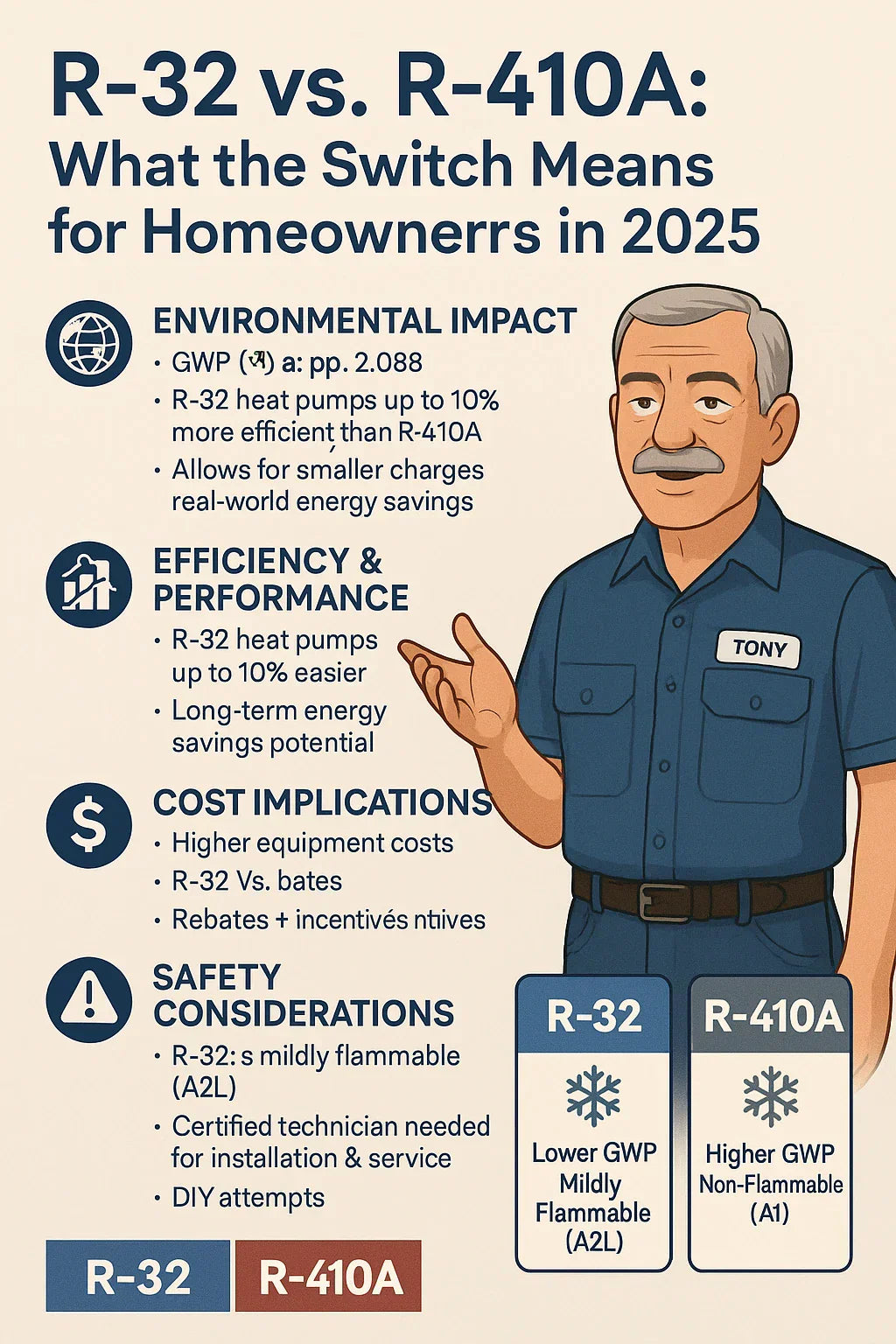Introduction: Why the Refrigerant Change in 2025 Matters - Best 2 Ton Heat Pump Systems
In January 2025, a major HVAC shift kicked in: R‑410A is being phased down in favor of greener alternatives like R‑32 and R‑454B, driven by the EPA under the AIM Act
As a homeowner in 2025, Tony knows this matters—not just for environmental reasons, but because cooling efficiency, long-term costs, and even system lifespan are changing.
❄️ 2. Understanding R‑32 and R‑410A
🔬 What Is R‑32?
-
Chemical formula: difluoromethane (CH₂F₂); a single-component HFC
-
GWP (100‑year): ~675, significantly below R‑410A
-
Mildly flammable (ASHRAE A2L); demands special installer training and safety protocols
🧪 What Is R‑410A?
-
Blend of R‑32 and R‑125; the dominant refrigerant in home systems since the 1990s
-
GWP: ~2,088 (vs. R‑32’s 675)—major climate concern
-
Non-flammable (ASHRAE A1), but high operating pressure demands specialized equipment
🌍 3. Environmental Impact
🌡️ Global Warming Potential (GWP)
-
R‑410A: 2,088
-
R‑32: 675 (~70% lower)
Lower GWP = less long-lasting impact if leaked.
🌏 Global and U.S. Policy
-
The AIM Act (2020) mandates an 85% HFC reduction by 2036. R‑410A phase-down begins in 2025
-
R‑32 (and R‑454B) meet the new standard of GWP ≤ 700 for new equipment after 2025
⚡ 4. Efficiency & Performance Differences
🧠 Thermodynamic Advantage
-
R‑32 transfers heat more efficiently, enabling higher SEER2/EER ratings.
-
Some designs show 10–30% better energy use compared to R‑410A systems
📉 Smaller Charge Volume
-
Due to its properties, R‑32 systems need 30% less refrigerant—meaning lighter components and cleaner handling
🧾 Real-World Gains
-
Brands like Daikin report up to 10% energy reduction in comparable testing
💰 5. Cost Implications for Homeowners
💵 Equipment Costs
-
Expect 20–30% higher upfront cost for R‑32-compatible units in early 2025 because of new design requirements
🧰 Service & Maintenance
-
R‑32’s lower required volume cuts down refill costs and reuse rates
-
As R‑410A supplies become scarcer, its per-pound cost climbs over time
⚡ Energy Savings
-
More efficient cycling, faster heat transfer, and better humidity control mean lower electric bills long term
🔐 6. Safety Considerations: What Homeowners Should Know
🔥 Flammability Risk
-
R‑32 is mildly flammable, ASHRAE A2L classification.
-
Requires UL-listed tools, proper ventilation, and installer certifications
👷 Installer Requirements
-
Must be trained and certified per EPA Section 608, AHRI, and UL 60335-2-40 standards
-
Proper handling avoids cross-contamination and ensures safe operation
🚫 DIY Pitfalls
-
Mixing R‑410A and R‑32 components invalidates warranties and violates code
-
Homeowners trying DIY may face safety or performance liabilities
🏡 7. What the Switch Means for Your Home HVAC
🔄 If You Already Own R‑410A
-
You can still use and maintain your current system—no immediate ban
-
But over time, servicing costs rise as refrigerant becomes scarcer and parts dwindle
⚙️ Can You Retrofit?
-
Usually no—core components, sensors, and safety systems differ
-
Mixing systems voids AHRI match certification and code compliance
📉 Incentives Favor R‑32
-
Federal tax credits & rebates under the Inflation Reduction Act apply more generously to systems <700 GWP
-
System must be matched and certified to qualify
💸 8. Rebates, Incentives & Tax Credits in 2025
✅ Energy Star & Federal Credits
-
R‑32 units often exceed Energy Star’s SEER2 thresholds and meet GWP criteria
-
Eligible for federal tax credits up to $900 or more (per AHRI‑matched systems)
🌎 State & Utility Rebates
-
Many state/local programs prioritize R‑32 or R‑454B systems
-
Tony’s tip: Check your state energy office or utility rebate database before buying to reduce out-of-pocket cost
🛠️ 9. Maintenance & Service Outlook
👨🔧 Technician Availability
-
Demand for A2L-certified HVAC techs is on the rise
-
Installers must keep separate R‑410A and R‑32 inventories and EPA sales logs
🛑 Leak Detection & Safety Protocols
-
R‑32 systems need automatic leak alarms, non-sparking tools, and ventilation verification
-
Regular inspections prevent refrigerant loss or hazard
🧺 Warranty & Parts Considerations
-
Components for R‑32 systems (valves, gaskets, sensors) differ—not interchangeable with legacy systems
📊 10. Real‑World Case Scenarios
Scenario A: Homeowner with 10-Year-Old R‑410A System
-
System still works fine, but at lower SEER by today’s standards
-
Servicing gets more expensive; supplies wane
-
Tony's suggestion: maintain for now, plan for full R‑32 swap within 2–3 yrs
Scenario B: Installing a New 2‑Ton R‑32 System
-
Benefits: lower operating cost, rebates, future-proof compliance
-
Must use matched indoor/outdoor unit, certified installer
-
Long-term ROI can outweigh higher installation cost
Scenario C: Cold Climate with Older Home
-
Energy efficiency matters more than ever
-
Use inverter/compressor R‑32 system to maintain performance in low temps
-
Be cautious: still requires right system sizing and backup heat
✅ 11. Tony’s Bottom Line: Should You Switch?
-
Plan to switch in 2025 if your system is over 8–10 years old or showing efficiency loss.
-
Keep using existing R‑410A only if still reliable—but expect rising maintenance cost.
-
Always install a fully matched, certified R‑32 system to ensure eligibility for rebates and compliance.
-
Work only with EPA‑certified pros experienced with A2L refrigerants and AHRI standards.
🏁 Final Thoughts
Switching from R‑410A to R‑32 in 2025 is more than just a technical update—it’s a future-focused upgrade. For Tony’s practical homeowner perspective: it means better efficiency, lower environmental impact, incentive eligibility, and peace of mind. Just remember—don’t DIY this one, get matched gear, seek certified installers, and capitalize on rebates. That’s how you keep your home comfortable, efficient, and compliant in 2025 and beyond.
In the next topic we will know more about: What Does a 2‑Ton R‑32 Heat Pump Cost in 2025? Budgeting for Equipment, Labor & Accessories







